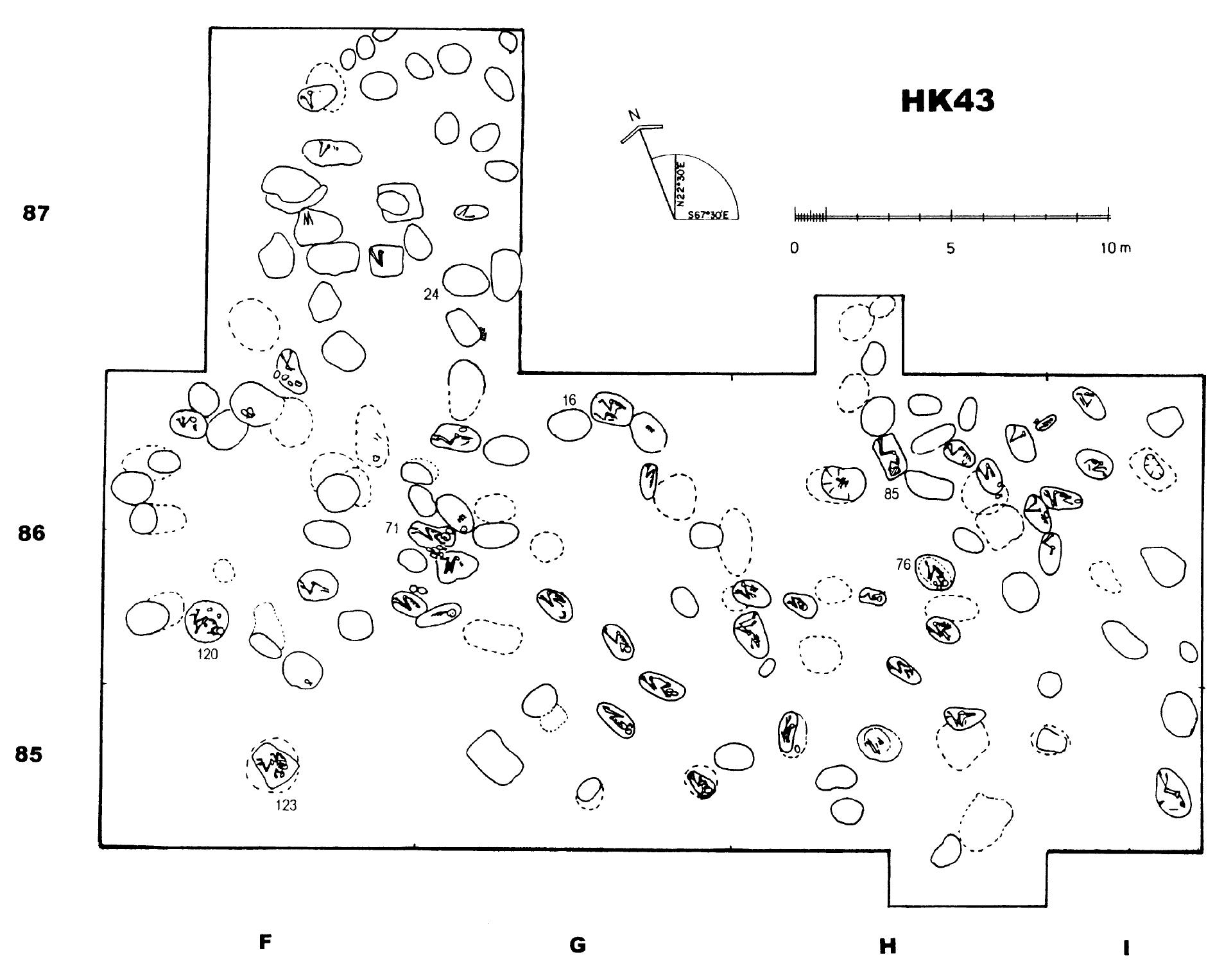
The cemetery called HK43 at Hierakonpolis, belonging to the non-elite (or workers) segment of the predynastic population, is located on the southern side of the site beside the Wadi Khamsini. HK43 holds over 500 individuals of Naqada IIB-IIC date (roughly 3650-3500 BC). Only 9% of all the burials in the HK43 cemetery were found intact.
 |
| Location of burials in the southern sector of HK43 |
A number of hair samples in the HK43 cemetery revealed the egg cases of head lice (Pediculus humanus capitis) in both a hatched and unhatched state, the latter indicating that the individuals in question had probably died while suffering from an infestation.
Mummy HK43 Burial 71
The first wrapped or padded body was found undisturbed in Burial 71 in 1997. This young woman (c. 25-30 years) wore extremely short crops, little more than 1cm long, leading to initial confusion that she was a man. She had been covered with matting and buried with eight pots, seven of which were placed before her head above the upper matting with only one placed behind the head beneath the matting. The pot behind her head still contained round loaves of bread, which contained very few actual grains, being composed mainly of chaff. Beneath the matting, her body was covered in a linen shroud.
Further examination of her remains has revealed what appears to be one of her internal organs wrapped in resin-soaked linen before being returned to the chest cavity where it was recovered.
Mummy HK43 Burial 16
Burial 16 was another padded burial, although heavily plundered. It belonged to an older woman (c. 30+ years) whose long hair was extremely well preserved beneath the 10cm thick linen pads. Unlike the other burials, it seems as if the entire head was padded given the large clumps of padding adhering to her hair. When this padding was removed, there was more artificial going on than just wrapping. Her graying locks had been dyed, as analysis has shown, with henna (Lawsonia inermis). Carefully knotted in to help fill out those graying and thinning locks were hair extensions, locks of her own hair, arranged to form what must have been a quite elaborate hair style, with a lot of lift in the center.
Mummy HK43 Burial 85
Burial 85 belonged to a young woman (16-20 years). She was discovered intact, still fully covered by a double layer of matting. Careful removal of the upper layer of matting and linen pads around the head resulted in the preservation of her entire head of hair, revealing a shoulder-length style of natural waves extending c.22cm from the crown of the head with a left side parting and asymmetrical fringe made up of S-shaped curls bordering the forehead. In addition to the excellent preservation of the cranial hair, the right eyebrow also survived.
Her throat bore eleven cut marks on the ventral surface of the atlas, indicating that her throat had been slit (but not decapitated) before the neck area was covered with linen pads. Cut marks were not found on any of the other wrapped bodies. Her burial contained no grave goods in the usual sense. Only a couple of rounded sherds and a flint flake were found in the crook of her knees.
Thick pads of resin-soaked linen had been carefully placed around the jaws and hands of all three females. Generally the finer textiles were against the body, the coarser on the outside. The threads were predominantly single, S-spun (clockwise rotation), with some two-plied (doubled), threads. The plied threads were S-spun and S-twisted.
Mummy S. 293 (Museo Egizio, Torino) (Provenance: unknown)
Mummy S. 293 was a male (20-30 years old) dated to roughly 3650-3500 BC. The results of the analysis of 'embalming agents' employed in the funerary treatment of the body revealed a complex mixture. The recipe consists of a plant oil, with far lesser amounts of a heated conifer resin, an aromatic plant extract/‘balsam’ and a plant gum/sugar. Most notable is the clear presence of a conifer resin in the textile sample from the wrist, in contrast to its presence only as a trace constituent in the textile sample from the torso. This may be related to the use of thick pads of resin-soaked linen placed around the jaws and hands at HK43 in Hierakonpolis.
The textiles from both the torso and the basket (associated with mummy S. 293) were woven of yarn first twisted in the ‘Z’ direction (i.e. to the right), and then doubled, or plied in the opposite, or ‘S’ direction (Z2S).
References:
http://www.hierakonpolis-online.org/index.php/explore-the-predynastic-cemeteries/hk43-workers-cemeteryJune 2, 2024 Takahiko Nakagawa